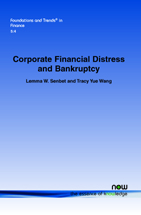Corporate Financial Distress and Bankruptcy: A Survey
By Lemma W. Senbet, William E. Mayer Chair Professor of Finance and Director, Center for Financial Policy, Robert H Smith School of Business, University of Maryland, USA, lsenbet@rhsmith.umd.edu | Tracy Yue Wang, Assistant Professor of Finance, Carlson School of Management, University of Minnesota, USA, wangx684@umn.edu
Abstract
This survey provides a synthetic and evaluative survey of issues in corporate financial distress and bankruptcy. This area has moved into a public domain as a result of the recent global financial crisis that witnessed failures of many venerable institutions that got rescued by the government. Hence, this survey highlights the resolution mechanisms not only in the private domain but also in the public domain, and it uses corporate finance paradigms to interpret some of the far-reaching developments in financial distress of systemic nature. This survey's theoretical anchor is a framework for the delineation of economic distress and financial distress. The difficulty in disentangling the dichotomy has been a central challenge in the empirics relating to financial distress, corporate bankruptcy, and the use of apparently cost-effective private mechanisms for resolving financial distress. This review devotes ample space on the discussion of conditions under which privatization of bankruptcy succeeds and fails, and the recent empirics on the subject. The review also grapples with the efficiency of bankruptcy codes and regimes, given the frequent usage of court-supervised mechanisms. The fundamental efficiency question about the bankruptcy law is whether the law effectively rehabilitates economically efficient but financially distressed firms and liquidates economically inefficient firms. This survey provides an ongoing debate in law and in economic theories about the efficiency of the U.S. bankruptcy code. Moreover, it examines a linkage between financial distress and corporate governance, which has received growing attention. The review goes beyond the United States to take a look at comparative bankruptcy codes around the world with a focus on bankruptcy reform issues in emerging economies. Finally, this survey takes us into a public domain and systemic financial distress. This is inspired by the recent global financial crisis. Is the standard bankruptcy procedure (e.g., those embedded in Chapters 11 and 7) sufficient for resolving systemic financial distress? The review attempts to answer this question in the context of the recently adopted landmark legislation, particularly the Dodd-Frank Act's Title II (Receivership), which governs the resolution of systemically critical institutions.
Corporate Financial Distress and Bankruptcy
Corporate Financial Distress and Bankruptcy has moved into a public domain due to the recent global financial crisis that witnessed failures of many venerable institutions that were rescued by the government. This led to landmark legislation in the form of the Dodd-Frank Wall Street Reform and Consumer Protection Act to provide resolution authority similar to private workouts but under government authority. This survey will highlight the resolution mechanisms not only in the private domain but also in the public domain and will use corporate finance paradigms to interpret some of these far-reaching developments in financial distress of systemic nature. Section II provides the institutional features of financial distress and bankruptcy, focusing on the workings of the US bankruptcy system. Section III provides a review of the major theoretical developments in corporate financial distress and bankruptcy. Section IV reviews the available empirical work on financial distress and bankruptcy and examines the question about the extent to which financial distress and bankruptcy costs are significant, and the extent to which these costs are internalized and externalized. The section also highlights important changes that have taken place over the last two decades in both private workouts and court-supervised resolution mechanisms. Section V looks at comparative bankruptcy codes around the world, which tend to vary along creditor rights and financial distress resolution mechanisms. Section VI examines the systemic nature of financial distress and bankruptcy. The authors provide a summary of all the discussions in Section VII so that readers can get a concise overview of the essential topics covered in this survey and some direction for future research on corporate financial distress and bankruptcy.
